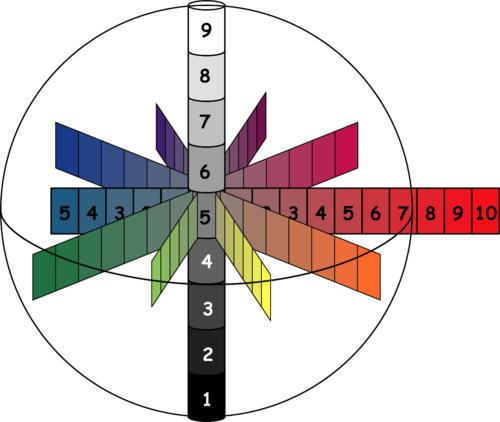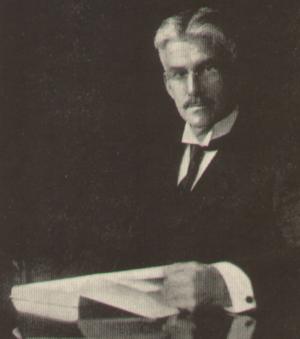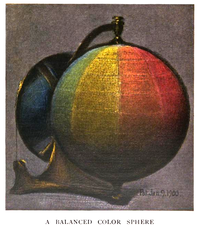 Hue, Value and Chroma Chart
Hue, Value and Chroma Chart
“He constructed a sphere on which were plotted a double set of spirals representing color sequences. From this model grew the evenly balanced Munsell Color Sphere, which demonstrates the exact relations of Hue, Value and Chroma.”
Munsell Color Wheel Step 1 on the Value pole in the center is the darkest gray possible. Step 9 is the lightest white. Absolute Black and White are not practically attainable. This illustration does not purport to be a correct representation of color standards, but is intended merely to visualize the three scales in as graphic form as possible by a printed diagram.

This perspective diagram graphically illustrates the three dimensions of color used by the Munsell Color Chart for color measurement and notation.
The first dimension is HUE, measured on the band or equator shown in perspective as encircling the central pole. This is divided into ten equidistant Hues arranged in the order of the spectrum:
Red, Yellow-Red, Yellow, Green-Yellow, Green, Blue-Green, Blue, Purple-Blue, Purple, Red-Purple. Five simple Hues and one compound Hue are printed in the diagram as they appear at these points. The other compound Hues are designated by letters only:
G-Y, P-B, R-P, Y-R.
In the second dimension of his color wheel, Munsell defines VALUE. It is measured on the central pole which is gray and neutral to all the Hues. This pole is divided into regular steps from dark to light. This dimension shows how light or dark a color may be.
The third dimension on this Munsell Colour Wheel is CHROMA, measured on the paths (shown in perspective) running from the neutral pole out to the equator or beyond it. This dimension measures the weakness or strength of a color. The Chroma scales of RED and its opposite Hue, BLUE-GREEN, are shown here at middle Value, from neutral out to the maximum strength of each. It will be noted that RED is twice as strong as BLUE-GREEN. The Chroma paths of the other Hues are indicated in outline only. Each of these paths may be drawn from any other step on the Value scale. Yellow, for example, which is weak at middle Value, can only attain its maximum strength at a higher step.
The dimension of Hue is expressed by a word or the initial letters of the word:
GREEN, YELLOW-RED, etc., or G, Y-R, etc.
The dimension of VALUE is expressed by the number of the step upon the Value scale, written over a line thus: 5/
The dimension of CHROMA is expressed by the number of the step on the Chroma scale, written below the line thus: /5
For example, the color at the extreme right of the diagram is Red, Value 5, Chroma 10 and is expressed as: R 5/10
 Excerpt from The Munsell Color System
Excerpt from The Munsell Color System
Mr. Munsell was fundamentally an artist. Upon graduating from the Boston Normal Art School, he was appointed instructor and awarded a three-year scholarship for the study of art abroad. After his return to this country he was made lecturer in Artistic Anatomy and Color Composition at the Normal Art School, he held this position with distinction for twenty-five years.
All throughout his student days Mr. Munsell was keenly aware of the lack of any practical theory of color. In fact, as far back as 1879, he placed two tetrahedrons base to base, applied balanced colors, and twirled them to produce a neutral gray. By 1898 he was spending all his spare time in widespread reading and experiment with the physical bases of pigment colors. He constructed a sphere on which were plotted a double set of spirals representing color sequences. From this model grew the evenly balanced Munsell Color Sphere, which demonstrates the exact relations of Hue, Value and Chroma. He also invented a small portable daylight photometer, which proved to be of the greatest assistance, not only in the measurement of colors, but also in the standardization of railroad signal lights. Most important of all, he accomplished the previously impossible task of publishing a standard color atlas.
By 1912 his work began to attract world-wide attention. In the spring of 1914 he was invited to present his invention at the meetings of the scientific societies of England, France and Germany. Although he contracted a severe cold on the voyage across, he was not willing to cancel any of his lectures. Enthusiastic audiences greeted him in London, Paris and Berlin. Large groups of ardent questioners kept him long over the scheduled time. This proved a heavy drain upon his already weakened constitution. In spite of his retirement from active work when he returned to this country, his health steadily declined until his death, June 28, 1918.
In February, 1918, a company bearing his name, Munsell Color Company, was incorporated with the threefold purpose of carrying on the scientific work which he had so ably begun, of furthering the introduction of his system into schools and colleges, and of taking the first steps in its application to the varied problems of the business world.
One of the first important applications of the system came in 1918, when the Strathmore Paper Company became interested in the project of making the Munsell Color System the basis of one of their distinctive advertising books. Mr. Munsell was deeply interested in this first application of his work, and agreed to write the introduction. As the work progressed, more and more interesting possibilities were discovered. Mr. T. M. Cleland was asked to write a popular explanation of the system to accompany Mr. Munsell’s introduction.
Additional colored pages were added, until in the spring of the present year, [Editor’s note – 1921] the Strathmore Paper Company published their beautiful book, “A Grammar of Color.” It is with their kind permission that the Munsell Color Company is reprinting Mr. Cleland’s remarkably simple and lucid article.
A. E. 0. Munsell
Wellesley Hills, Mass.
Nov. 1, 1921
* “Color Notation,” Geo. H. Ellis, Boston, 1919, page 76.

 Hue, Value and Chroma Chart
Hue, Value and Chroma Chart Excerpt from The Munsell Color System
Excerpt from The Munsell Color System




























